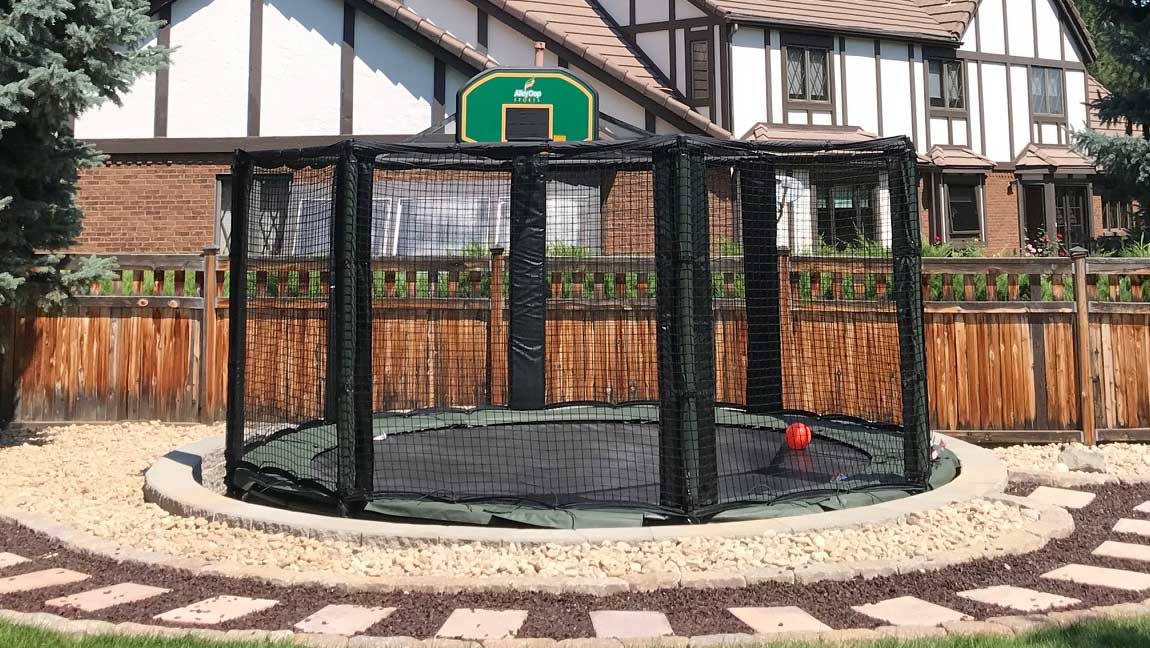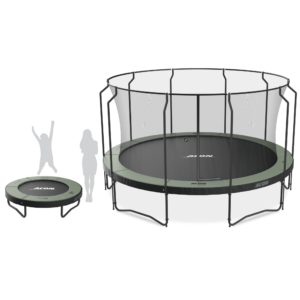An in-ground trampoline is a type of trampoline that is installed below ground level, creating a level surface with the surrounding ground. This differs from traditional above-ground trampolines that sit on legs and require a safety net enclosure.
In-ground trampolines offer several advantages over traditional trampolines, including easier access for young children or people with mobility challenges, improved aesthetics, and increased safety. Additionally, they are less likely to tip over or suffer damage during storms or high winds. In-ground trampolines can be installed in a backyard or other outdoor space and are available in a range of sizes and shapes to suit different needs and preferences.
Is it a good idea to put a trampoline in the ground?
There are several benefits to installing an in-ground trampoline, and it can be a good idea for many people. Here are some reasons why:
- Safety: In-ground trampolines are considered safer than above-ground trampolines because they have a lower profile and are less likely to cause injuries from falls. Additionally, since the trampoline is level with the ground, there is less risk of someone falling off the trampoline onto the ground.
- Aesthetics: An in-ground trampoline can be more aesthetically pleasing than an above-ground trampoline. It blends into the landscape more easily and does not obstruct the view of the yard as much.
- Accessibility: In-ground trampolines can be easier to access, especially for young children or people with mobility challenges. They don’t require a ladder or steps to climb up onto the trampoline, making it easier to use.
- Durability: In-ground trampolines are generally more durable than above-ground trampolines. They are less likely to be damaged during high winds or storms, and they can also withstand heavy use over time.
However, it’s important to note that installing an in-ground trampoline can be a significant project and may require professional installation. Additionally, they can be more expensive than above-ground trampolines. It’s important to weigh the pros and cons and make an informed decision based on your needs and budget.
Why get an inground trampoline?
There are several reasons why people choose to get an in-ground trampoline:
- Aesthetics: In-ground trampolines can blend seamlessly into the surrounding landscape, creating a more aesthetically pleasing look than above-ground trampolines.
- Safety: In-ground trampolines are closer to ground level, which can reduce the risk of injury from falls. Additionally, many in-ground trampolines come with safety features such as safety nets or padding, which can further enhance safety.
- Accessibility: In-ground trampolines can be easier to access for people of all ages and abilities since there are no ladders or steps required to access the trampoline.
- Durability: In-ground trampolines are typically more durable and long-lasting than above-ground trampolines since they are protected from weather conditions and have a solid foundation.
- Fun: In-ground trampolines can provide hours of fun and entertainment for the whole family, and can be used for exercise, sports, or just jumping around.
It’s important to note that in-ground trampolines require proper installation, maintenance, and safety measures to ensure optimal performance and safety. It’s recommended to consult with a professional installer or the manufacturer’s instructions to determine the best option for the specific installation.
What happens to an inground trampoline when it rains?
In-ground trampolines are designed to withstand outdoor conditions, including rain. However, without proper drainage, rainwater can accumulate on the surface of the trampoline, making it slippery and unsafe to use.
To prevent water accumulation, in-ground trampolines are typically installed with drainage systems, such as French drains, perforated pipes, or sloping. These drainage systems help to redirect water away from the trampoline and prevent it from pooling on the surface.
In addition to drainage systems, many in-ground trampolines also come with weather-resistant features, such as rust-resistant frames and UV-resistant jumping mats, which can help protect the trampoline from the effects of rain and other weather conditions.
It’s important to regularly inspect the drainage systems and other weather-resistant features of the in-ground trampoline to ensure that they are functioning properly and to prevent any potential damage or safety hazards. If water does accumulate on the surface of the trampoline during rain, it’s recommended to wait until the trampoline has dried before using it to ensure safe and optimal performance.
What do you put under an inground trampoline?
There are several options for what to put under an in-ground trampoline, depending on personal preference, budget, and the specific needs of the installation. Here are some common options:
- Drainage Material: A layer of drainage material, such as gravel or crushed stone, can be placed at the bottom of the hole to promote proper drainage and prevent water accumulation.
- Shock-Absorbing Material: A layer of shock-absorbing material, such as foam pads or rubber mulch, can be placed under the trampoline to provide a soft landing surface and reduce the risk of injury.
- Landscape Fabric: A layer of landscape fabric can be placed over the drainage material or shock-absorbing material to prevent weeds and other vegetation from growing and interfering with the trampoline.
- Safety Netting: For added safety, a layer of safety netting or padding can be installed around the perimeter of the trampoline to prevent falls and injuries.
It’s important to note that the type of material used under the in-ground trampoline can affect its performance and safety, so it’s recommended to consult with a professional installer or the manufacturer’s instructions to determine the best option for the specific installation. Additionally, regular maintenance and inspection of the area under the trampoline can help ensure optimal performance and safety.
What are the benefits of in ground trampoline?
In-ground trampolines offer several benefits compared to traditional above-ground trampolines, including:
- Safety: One of the biggest benefits of in-ground trampolines is their increased safety compared to above-ground trampolines. Since the trampoline is installed at ground level, the risk of falls from a high height is significantly reduced. Additionally, many in-ground trampolines come with safety features like safety nets or padding, which can further enhance safety.
- Aesthetics: In-ground trampolines are more aesthetically pleasing than above-ground trampolines since they blend seamlessly into the surrounding landscape. This can make your yard look more polished and can even increase the value of your property.
- Accessibility: In-ground trampolines are much easier to access than above-ground trampolines, as there are no steps or ladders required to climb up to the trampoline. This makes them more accessible to people of all ages and abilities.
- Durability: In-ground trampolines are more durable than above-ground trampolines since they are protected from weather conditions and have a solid foundation. This means that they are less likely to rust, degrade, or tip over, which can increase their lifespan.
- Fun: In-ground trampolines can provide hours of fun and entertainment for the whole family. They can be used for exercise, sports, or just jumping around, and can be enjoyed by people of all ages.
Overall, in-ground trampolines offer a safer, more aesthetically pleasing, and more accessible option than traditional above-ground trampolines. They are also more durable and provide just as much fun and entertainment as above-ground trampolines.
How do you make an inground trampoline?
Making an in-ground trampoline requires several steps, including excavation, installation of a frame and mat, and proper drainage. Here are the basic steps to make an in-ground trampoline:
- Choose a location: Select a flat area with enough space to accommodate the trampoline and surrounding safety area. Avoid areas with trees or overhead wires.
- Excavation: Dig a hole that is deeper than the trampoline frame and wide enough to allow for drainage and installation. The depth and width of the hole will depend on the size and type of the trampoline.
- Install the frame: Install the trampoline frame in the hole, making sure it is level and stable. Some frames may require anchoring to the ground.
- Add drainage: Install a drainage system, such as a French drain or perforated pipe, around the perimeter of the trampoline to prevent water accumulation.
- Add safety measures: Install safety measures, such as a safety net, padding, or enclosure, around the perimeter of the trampoline to prevent falls and injuries.
- Install the mat: Install the trampoline mat onto the frame, making sure it is secure and centered.
- Test the trampoline: Check the trampoline for proper bounce and stability before use.
It’s important to note that the process of making an in-ground trampoline can be complex and time-consuming, requiring proper excavation, drainage, and safety measures. It’s recommended to hire a professional installer who has experience with this type of installation to ensure the job is done correctly and safely.
How do in-ground trampolines drain?
Proper drainage is an important aspect of installing an in-ground trampoline. Without proper drainage, rainwater and other liquids can accumulate on the surface of the trampoline, making it slippery and unsafe to use. There are several ways in-ground trampolines can be drained:
- French drain: A French drain is a trench filled with gravel or rock that redirects water away from the trampoline. The drain is installed around the perimeter of the trampoline, allowing water to flow into the trench and away from the trampoline.
- Perforated pipe: A perforated pipe can be installed around the perimeter of the trampoline, allowing water to flow through the pipe and away from the trampoline.
- Sloping: The area around the trampoline can be sloped away from the trampoline to direct water away from the surface. This method requires careful planning during installation to ensure that the slope is sufficient to prevent water accumulation.
- Sump pump: A sump pump can be installed to remove excess water from the area around the trampoline. The pump is typically installed in a pit or well, and it pumps the water away from the trampoline through a hose or pipe.
It’s important to consider the drainage options during the installation process to ensure that water does not accumulate on the surface of the trampoline. A professional installer can help determine the best drainage solution based on the specific location and other factors.
How deep do you have to dig for an inground trampoline?
The depth required for an in-ground trampoline depends on the size and type of the trampoline. In general, the hole for the trampoline should be deep enough to ensure that the trampoline sits level with the ground and is stable.
For most in-ground trampolines, the hole needs to be between 2 to 4 feet deep, although the depth can vary depending on the manufacturer’s recommendations. Some manufacturers may recommend a specific depth based on the size and weight of the trampoline. It’s important to consult the manufacturer’s instructions or consult with a professional installer to determine the appropriate depth for the specific trampoline being installed.
Additionally, the hole should be wider than the trampoline frame to allow for proper installation, leveling, and drainage. The width of the hole should be at least 2-3 feet wider than the diameter of the trampoline.
It’s important to note that in-ground trampoline installation can be a complex and time-consuming process that requires proper excavation, leveling, and drainage. It’s recommended to hire a professional installer who has experience with this type of installation to ensure the job is done correctly and safely.
How much does it cost to put a trampoline in the ground?
The cost of installing an in-ground trampoline can vary depending on several factors such as the size and shape of the trampoline, the type of installation required, the local labor costs, and the materials used.
On average, the cost of installing an in-ground trampoline can range from $1,500 to $5,000 or more, including the cost of the trampoline itself. However, the cost can be higher or lower depending on the specific requirements of the project.
It’s important to note that in-ground trampoline installation can be a complex and time-consuming process that requires excavation, leveling, and proper drainage. It’s recommended to hire a professional installer who has experience with this type of installation to ensure the job is done correctly and safely.
Overall, the cost of an in-ground trampoline can be higher than an above-ground trampoline, but the benefits of safety, aesthetics, and accessibility can make it a worthwhile investment for those who are looking for a long-term and high-quality trampoline experience.
Is jumping trampoline better than running?
Both jumping on a trampoline and running can provide excellent cardiovascular exercise, but they have different benefits and considerations.
Jumping on a trampoline provides a low-impact workout that is easier on the joints than running. It can improve balance, coordination, and muscle strength in the legs, core, and back. Additionally, jumping on a trampoline can be a fun and enjoyable way to exercise, which can lead to increased motivation and adherence to a fitness routine.
Running, on the other hand, is a high-impact workout that can improve cardiovascular fitness and endurance. It can also burn more calories than jumping on a trampoline, making it a more efficient workout for weight loss.
The best exercise option for an individual will depend on their personal fitness goals, physical abilities, and preferences. A combination of different exercises can provide a well-rounded fitness routine that includes both cardio and strength training.
It’s important to note that both jumping on a trampoline and running come with some risks of injury, and proper safety measures should be taken to minimize the risk of falls or other accidents. Additionally, it’s recommended to consult with a healthcare professional before starting a new exercise routine.
What is the difference between an inground and flatground trampoline?
An in-ground trampoline is installed into a hole that is dug into the ground, so the trampoline sits at ground level. A flatground trampoline, also known as a low-profile trampoline, is designed to sit directly on the ground without any excavation.
Here are some key differences between in-ground and flatground trampolines:
- Aesthetics: In-ground trampolines blend seamlessly into the surrounding landscape, while flatground trampolines can be more noticeable and may impact the aesthetics of the area.
- Safety: In-ground trampolines are closer to ground level, which can reduce the risk of injury from falls. However, flatground trampolines can also be made with safety features such as enclosures and padding to ensure safe use.
- Installation: In-ground trampolines require excavation, while flatground trampolines can be set up directly on the ground without any digging. In-ground trampolines are typically more complex and time-consuming to install.
- Durability: In-ground trampolines are protected from weather conditions and have a solid foundation, which can make them more durable and long-lasting than flatground trampolines.
- Bounce: In-ground trampolines typically have a higher bounce since they are installed deeper into the ground, while flatground trampolines may have a lower bounce.
The choice between an in-ground and flatground trampoline will depend on personal preference, available space, and budget. Both types of trampolines can provide hours of fun and exercise, but it’s important to ensure proper safety measures are in place to prevent injuries.
Conclusion
In-ground trampolines offer several benefits compared to traditional above-ground trampolines, including increased safety, aesthetics, accessibility, durability, and fun. They are installed into a hole that is dug into the ground, so the trampoline sits at ground level, reducing the risk of falls from a high height.
In-ground trampolines also blend seamlessly into the surrounding landscape, making them more aesthetically pleasing and increasing the value of your property. They are easier to access, more durable, and provide just as much fun and entertainment as above-ground trampolines. Overall, in-ground trampolines are a great option for those looking for a safer, more aesthetically pleasing, and more durable trampoline experience.
You May Also Like These Deals!
How to Choose the Correct Trampoline Size
Which trampoline size is ideal for your family and backyard?...
Read MoreHow to choose the best trampoline for kid
Numerous trampoline models are available, ranging from inexpensive to premium...
Read MoreBest Black Friday Trampoline Deals
This year, are you looking for a trampoline? There are...
Read MoreProducts recommended in the post contain affiliate links. We may receive a commission when you buy something through our posts.
Why Trust Us
You will find what you are looking for at Black Friday Weeks. From classic to luxury brands, you'll find both. We will help you to select appliances that fit your needs, budget and lifestyle. Whether you want to stop by to learn more — or plan to make a major purchase — we’ll treat you like family and assist you every step of the way. Shop with us today to receive friendly and experienced help along the way.




